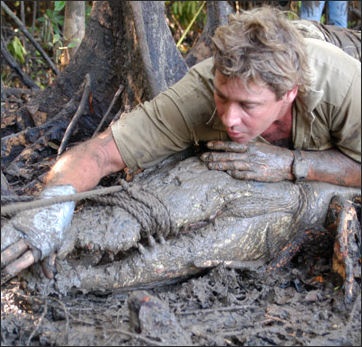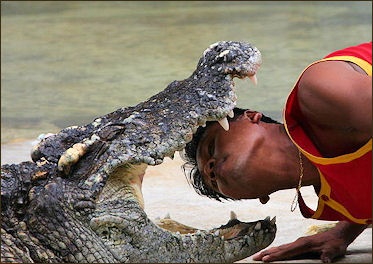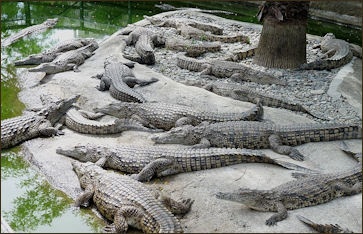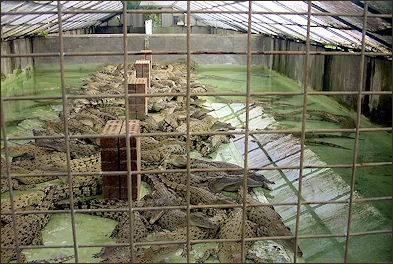CROCODILES AND HUMANS

Steve Irwin with a crocodile
Crocodile are considered to be sacred and many are kept in temple pools to be worshiped. Still hunters snare for their skins. Crocodile meat is consumed in some countries, such as Australia, Ethiopia, Thailand and South Africa. It is eaten in in pickled form in Cuba and found in specialty restaurants in some parts of the United States. Two restaurants in the Bangkok area specialize in crocodile meat dishes. Many of the customers are Chinese. Crocodile meat is white. Some say it has a light taste like shellfish or lobster: "white, light and tender, surprisingly unfish like."
Crocodiles are easier to spot during the night than the day. Their eyes turn red when a flight is flashed on them. Crocodiles poachers hunt mostly at night. The shine lights into the animal's eyes and spear them or shoot them. On the Liverpool River in northern Australia hunters used to bag forty crocodiles a night by stunning them with bright lights. It is now against the law to hunt crocodiles in Australia.
Steve Irwin wrote in his website: “In the water, crocodiles are impossible to study. It’s very difficult to accurately estimate their size when all you see is a head that looks like a piece of driftwood from a distance. Once a croc basks on a mud bank, he leaves a track which is all the evidence that’s needed to understand the size, density, hierarchy and behavioral patterns of the crocodiles in the area. A track left in the mud is known as a 'slide’. [Source: Steve Irwin’s Crocodile Hunter website ]
Alligators have been fished out the New York City reservoirs but never a sewer. Saltwater crocodile are reportedly very fond of eating dog and according to some witnesses will head in the direction of barking canine. An alligator hunter in Louisiana told National Geographic, that after snagging an alligator on a chicken-baited hook, “It’s like pulling in a log.” That is “until the alligator sees you. Then the battle begins. Winston Churchill was among those who did not look upon crocodiles with MUCH affection. He once wrote "I avow...an active hatred of these brutes and a desire to kill them."**
RELATED ARTICLES:
HOW TO CATCH A CROCODILE factsanddetails.com
CROCODILE ATTACKS IN ASIA factsanddetails.com
CROCODILES: CHARACTERISTICS, ANATOMY, DIFFERENCES WITH ALLIGATORS factsanddetails.com
PREHISTORIC CROCODILES: EVOLUTION, EARLIEST SPECIES, TRAITS factsanddetails.com
CROCODILE BEHAVIOR: COMMUNICATION, FEEDING, MATING factsanddetails.com
SPECIES OF CROCODILES IN ASIA factsanddetails.com
SALTWATER CROCODILES factsanddetails.com
CROCODILES IN AUSTRALIA: HISTORY, SPECIES, BIG ONES, DWARVES, BATS, SHARKS ioa.factsanddetails.com
CROCODILE CULTURE AUSTRALIA: URBAN CROCS, ABORIGINALS, DUNDEE, STEVE IRWIN ioa.factsanddetails.com
CROCODILE ATTACKS IN AUSTRALIA: HOW, WHERE, WHY, DETAILS ioa.factsanddetails.com
CROCODILE ATTACKS IN NORTHERN TERRITORY AUSTRALIA ioa.factsanddetails.com
SURVIVING CROCODILE ATTACKS IN AUSTRALIA ioa.factsanddetails.com
Websites and Resources on Animals: Reptile Database reptile-database.org ; Reptileweb reptilesweb.com ; Reptile Phylogeny whozoo.org/herps/herpphylogeny ; Animal Diversity Web animaldiversity.org ; BBC Earth bbcearth.com; A-Z-Animals.com a-z-animals.com; Live Science Animals livescience.com; Animal Info animalinfo.org ; World Wildlife Fund (WWF) worldwildlife.org the world’s largest independent conservation body; National Geographic National Geographic ; Endangered Animals (IUCN Red List of Threatened Species) iucnredlist.org
Crocodiles and the Ancient Egyptians
The Egyptians revered crocodiles. Their river god Sobek is modeled after one. Entire crocodiles families were mummified and placed in sacred tombs with gold bracelets placed on their ankles. A Greek historian visiting an Egyptian Crocodileopolis saw priests feed them honey wine and cakes.

The Egyptians revered crocodiles. Their river god Sobek is modeled after one. Entire crocodiles families were mummified and placed in sacred tombs with gold bracelets placed on their ankles. A Greek historian visiting an Egyptian Crocodileopolis saw priests feed them honey wine and cakes.
Crocodiles were a real danger to the Egyptians and, like other dangerous animals, were given divine status (in their case as the god Sobek) in the hope that in return they would not attack humans. The Nile crocodile can grow to six metres in length, and there are many tales of Ancient Egyptians being killed by them. Crocodiles are no longer found in Egypt. [Source: Robert Partridge, BBC, February 17, 2011]
There were a number of local Nile gods. Sobek (Sebek) was a local crocodile god popular in southern Egypt. He was honored as a god of fertility because the Nile floods brought fertile soil to the farmlands. Live crocodiles were kept at temples honoring Sobek and priests there may have bred crocodiles for ritual use.
See Separate Article: CROCODILES IN ANCIENT EGYPT: MUMMIES, WORSHIP, TEMPLES factsanddetails.com
Crocodile Shows
Thai crocodile wrestlers perform stunts like reaching down the throat of a crocodiles and sticking heir head inside a crocodile’s mouth. Crocodiles wrestlers say the secret to their trade is choosing the right crocodile: one that hold its mouth open for a long time and are stable and predictable. Trainers use bamboo sticks to control the crocodiles. Animal that don’t do what they are told are whacked on the head.
Many of the crocodile farms in Thailand hire children to perform tricks like sticking their nose in the jaws of a crocodile. One 11-year-old who was famous for kissing two-meter-long crocodiles on the their snout told AP, “Crocodiles cannot be tamed. They have small brains. They attack only when made angry. You must practice moving faster than they do and staying calm.”
Endangered Crocodiles

gharial
Although some species of crocodilians such as the American alligator and Nile crocodile are thriving many other species are having a hard time as humans expand into their traditional habitats. Some species such as the gharial may be extinct in the wild within a decade. The good news is that crocodile are relatively easy to breed in captivity and some species have been successfully released after being raised by humans. In addition, crocodile their populations can quickly rebound if conservation measures are taken as has been the case with alligators in the U.S. and saltwater crocodiles in Australia.
Several species including the gharial, Cuban crocodile, Orinco crocodile and false gharials are in danger of extinction. Crocodiles have been shot as pests, poached for skins and hunted for food. Their swamps have been drained to create more cultivated land. Rivers they live in have been damaged by pollution, overfishing and development.
Mel White wrote in National Geographic, “Species such as the Chinese alligator and the Philippine crocodile have virtually no natural habitat left, squeezed out of their former ranges by agricultural and urban growth. [Source: Mel White, National Geographic , November 2009]
Explaining why endangered crocodiles have not been embraced by animal lovers like pandas, polar bears and elephants, Wayne King of the New York Zoological Society said: "They're not cuddly. They don't have big soulful eyes like seals. Most of the animals the world is concerned with are beautiful, or they tug at your heartstrings. Crocodiles have a toothy leer. They eat dogs...sometimes even people. Who could love them?"**
Crocodile Conservation
Many species gave come back thanks to wetlands protection laws, bans on hunting and trafficking of endangered animals. Crocodile farms satisfy the demand for crocodile leather. Mel White wrote in National Geographic, “Species such as the Chinese alligator and the Philippine crocodile have virtually no natural habitat left, squeezed out of their former ranges by agricultural and urban growth. Some crocodilians found in remote parts of the world are not in immediate danger, and others such as the American alligator have made dramatic recoveries. But it remains to be seen how many can endure in a world where their wetland homes are coveted by people from subsistence farmers to golf course designers---and where some species make themselves less than welcome by eating pets and even people. [Source: Mel White, National Geographic , November 2009]
“The main change in recent crocodilian conservation has been the decline in illegal hunting for skins," John Thorbjarnarson of the Wildlife Conservation Society, told National Geographic. It's been replaced by legally managed ranching and harvesting, allowing some species to rebound. "Whereas 20 years ago there may have been 15 or 20 species that were listed as endangered," Thorbjarnarson says, "now there are really only seven, all reflecting the loss of most of their habitat."
Crocodile Skin Industry

Crocodile leather can be made into goods such as wallets, briefcases, purses, handbags, belts, hats, and shoes. In French a company used to make portable bar made of salt water crocodile skin. Crocodile hides sell for between $180 and $360. In Louisiana about 240,000 farm-raised alligators are harvested every year and 34,000 wild ones are killed. In 2008, hides and meat earned the state nearly $60 million.
The French company Hermes is the largest manufacturer of crocodile products in the world, with wallets starting at around $300 and handbags that go for as much as $10,000. Although Hermes and other companies once purchased poached skins most animals used to make purses, wallets and shoes are raised in crocodile farms in places like Thailand, Singapore, China and Papua New Guinea.
Farmed crocodile are generally raised until they are ready to be skinned for leather products. Often just a small amount of the hide is taken for leather and the rest of the crocodile is thrown out or fed to other farmed crocodiles.
The owners of crocodile farms in Australia collect eggs from female nests. "We draw straws to see who collects the eggs," one farmer owner told National Geographic. "You have to carefully put a pencil mark on top of each egg as its sits. If the egg is turned over, the embryo smothers under the egg mass. The person who collects the eggs the doesn't have a stick to push the crocs away, just that bloody pencil." After the eggs the crocodiles must be carefully taken off so they don't die from stress. After maturing to six-foot animals in about three years the crocodiles are killed, skilled and exported. mostly to Paris. Australia exports about 5,000 skins, worth around $2 million, each year.
Hermes Breeds Its Own Crocodile to Meet Bag Demand
In 2009, French luxury goods group Hermes said had resorted to breeding its own crocodiles on farms in Australia to try to meet demand for its leather bags. Reuters reported: Customers sometimes have to wait several years for certain exotic-skin bags, which can fetch over 35,000 euros ($48,410). "It can take three to four crocodiles to make one of our bags so we are now breeding our own crocodiles on our own farms, mainly in Australia," Patrick Thomas told the Reuters, [Source: David Jones, Reuters, Jun 8, 2009]

“Hermes already faces a major challenge producing 3,000 crocodile bags a year, Thomas said, adding: "The world is not full of crocodiles, except the stock exchange!" Crocodile farming can be expensive, with the reptiles having to be kept apart in separate rooms to protect their skins from bites, but even so allowances have to be made for natural losses that can amount to around a third of bred crocodiles.
“Hermes' leather goods, which account for 40 percent of its business, have been the most robust in the current downturn with the group taking on 50-100 leather workers this year to add to the 2,000 craftsmen it already employs at French sites. Thomas admits the group has been pushing other areas of the business, such as fashion and textiles, so it is not so reliant on leather bags, but says this area continues to be its fastest-growing product line. "We cannot face demand. We have massive over-demand. We are limited by our ability to train new craftsmen," he added.
Luxury Hermes and Louis Vuitton Crocodile Handbags
Janice Kew and Andrew Roberts wrote in Businessweek, “These days, women of every economic stripe can be seen carrying pricey leather handbags. Not so with totes made of crocodile, one of the most difficult luxury materials to obtain, especially in the pristine condition wealthy fashionistas expect. As demand from the world’s elite surges for the skins, luxury goods companies such as LVMH Moët Hennessy Louis Vuitton and Kering, the owner of Gucci, are making acquisitions to secure a supply of the beasts, whose habits make even collecting their eggs a matter of life and death. Keeping crocodiles from scratching or biting each other as you raise them from hatchling to arm candy is another major challenge. [Source: Janice Kew and Andrew Roberts, Businessweek, October 24, 2013]
“Louis Vuitton, Prada, and Gucci are trying to elevate the level of perceived exclusivity of their brands, and exotic-skin products really help,” says Mario Ortelli, an analyst at Sanford C. Bernstein. Such skins make up almost 10 percent of the total revenue for luxury brands’ handbag sales, at least double their share a few years ago, he estimates. The incentive for luxury goods companies, many of which are wrestling with sluggish demand for their most widely available products, is clear: Crocodile handbags can cost more than 10 times similar leather ones.
“An Hermès International Birkin bag, a staple of the wealthy, sells for about $10,000 in leather; the croc version runs about $50,000—with a five-year wait. For those who lack such patience, they’re available used on EBay (EBAY) for as much as $150,000. “There are women who don’t care about money that love the beautiful things,” says Gianluca Brozzetti, chief executive officer of fashion house Roberto Cavalli. “Demand for crocodile and alligator is large because I think it is one of the trends that never ends. It is a classic.”
Crocodile's Journey From Farm to Prada Handbag
Janice Kew and Andrew Roberts wrote in Businessweek, “Although saltwater porosus crocodiles can fetch higher prices, freshwater Nile crocs found in Africa aren’t as territorial or aggressive—although they’re hardly friendly. “If I’d known how hard this business was before I’d got into it, I may not be here today,” says Stefan van As, a former investment banker and owner of South Africa’s Le Croc breeding farm and tannery, which sends about 5,000 Nile crocodile skins to Europe each year. [Source: Janice Kew and Andrew Roberts, Businessweek, October 24, 2013 ]
Cow-leather hides are a byproduct of animals raised for beef. For a crocodile farmer, it’s the skins that pay the bills. (Some people consider croc meat a delicacy, but growers such as Van As simply feed it to the other animals.) An average handbag can be crafted from as few as two skins, for which Van As gets as much as $600 each.

While cows can ruminate for hours on their own in a meadow, from the moment a crocodile hatchling snaps its way out of the egg, Van As has to provide a calm environment to keep the critter from getting restless and damaging its hide. So the reptiles have their pens cleaned daily and are kept on a strict feeding schedule. They dine mostly on chicken and vitamin-fortified oils to improve their skin. All this care promotes growth, reduces stress, and helps keep the contented crocs’ jaws off each other. “The bottom line is that one cannot expect to harvest a first-grade skin from an animal which has been abused,” Van As says.
Nile crocodiles grow to about 16 feet long and weigh up to 1,500 pounds, or about two-thirds the size of the biggest porosus. And they’ll eat almost any prey that ends up in the water. Van As says a rival farmer was killed after falling in. “These are prehistoric animals that rely on instinct to protect themselves,” says Loic Bellet, a marketing executive at Via la Moda, which makes crocodile handbags in Johannesburg. “Obtaining a perfect skin is not easy.”
To protect the belly—the best part for bags—the slaughter, skinning, and even some of the tanning process at Le Croc are done by hand. At about three years of age, when they weigh roughly 50 pounds and are about 6 feet long, the animals are slaughtered. Van As carefully stuns his crocs twice, then cuts the nape of their necks and scrambles their brains with a needle. Some farmers are less gentle, Ben Williamson, a spokesman for People for the Ethical Treatment of Animals, said in an e-mail. This “often results in the crocodile enduring multiple blows, leading to a slow and painful death.”
To help avoid slaughter of wild crocodiles, each skin needs a certificate proving it’s not in violation of international protocols protecting endangered species. Thanks to the success of farming, which yields higher-quality skins, crocs no longer face extinction. LVMH in February bought an Australian crocodile farm for $2.5 million to assure a steady flow of the animals. The following month, Kering bought tannery France Croco, a Normandy-based operation specializing in the sourcing and processing of crocodile skins for makers of leather goods. “It’s complicated to buy exotic skins,” says Jean Cassegrain, CEO of luxury house Longchamp, which sometimes purchases croc skins from rival luxury houses. “The supply is very limited.”
Crocodile Farms in Thailand

Thailand is a leader in crocodile farming. In the 1990s there were more than 200 crocodile breeders in Thailand, most of them on the central plain provinces of Uthai Thani, Nokron sawan, Chainat, Prachin Buri, Chonburi and Sumut Prakarn. The largest crocodile farm in Thailand, in the Samut Prakarn province near Bangkok, has 30,000 crocodiles.
There is a Thai saying, "Don't feed the tiger cubs, don't feed the crocodiles." But a crocodile breeder named Amorn Chittapinichmat told Reuter "but these days people feed crocodiles can become millionaires." Amorn has a laboratory in his house for incubating and hatching crocodile eggs, which are kept on long trays. Finger-length crocodiles hatch after about 10 weeks and after six weeks are moved to tanks on the roof which hold more than 400 reptiles less than a year old. After the crocodiles are a year old they are moved to large ponds on the banks of a river.
In the 1990s Amorn had about 1,000 crocodiles in his pond, which range in length from two to four meters. New born crocodiles are worth about $88, but a mature seven- to ten-year-old between two and three meters in length can fetch $1,600 to $2,000.
Most of the crocodile skins are shipped to Europe where they are made into belts, purses and shoes. The meat is exported to Asian countries, especially ones with a large Chinese population that consider crocodile meat a delicacy and the ground up skull and teeth are used in medicines. Dry crocodile meat sells for about $120 a kilo and a crocodile belt goes for about $100.
When 300 crocodiles escaped from their farms during a period of heavy flooding in 1995, the government offered a bounty of $120 for each captured animal. A special task forced code named "Kraithong 1,2 and 3" after a famous mythical Thai hunter asked people to kill the animals only if they resisted arrest or were more than three meters long.
Crocodile Farms in China
In the mid-1990s, China's forestry department eliminated duties on the import of breeding crocodiles as way of develop a crocodile leather and meat industry to provide jobs for farmers losing their land. Over the past decade China has imported tens of thousands of crocodiles from Thailand, accompanied by Thai handlers, to get the industry going in southern China.
The crocodile industry in China has suffered a number of setbacks. The crocodiles from Thailand have had trouble adapting to the slightly cooler temperatures of southern China and often don't like the food that is served them. The biggest problem is that the males tend to overeat and become sluggish in the autumn and winter and have no interest in sex when the breeding season rolls around in the spring. Success in crocodile farming means having lots of breeding crocodiles producing new sources of meat and leather.

crocodile meat
The cool temperatures at night make the crocodiles more likely to get sick and paying for antibiotics and other medicines and injecting them as they sit in pools is expensive and labor-intensive. The crocodiles also didn't like the ducks and fish from local ponds they have been given. They prefer more expensive chicken. To make matters worse the Thais who sold the Chinese the crocodiles slipped in a lot overaged males and females who were too old to reproduce.
Crocpark Guangzhou is the world's largest crocodile farm with 60,000 to 70,000 animals. In 1997 and 1998, taking advantage of low prices caused by the Asian financial crisis, it bought 40,000 crocodiles for as little as 75 cents a piece. The crocodiles, ranging in size from a few centimeters to six feet, filled the holds of five 747 cargo jets. The park loses money because it can't get the crocodiles to breed. To make money it has opened its doors to tourists who pay $1.25 for a bamboo pole with two chicken torsos attached to them to feed to the crocodiles.
Image Sources: Wikimedia Commons
Text Sources: Animal Diversity Web animaldiversity.org ; National Geographic, Live Science, Natural History magazine, David Attenborough books, New York Times, Washington Post, Los Angeles Times, Smithsonian magazine, Discover magazine, The New Yorker, Time, Reuters, Associated Press, AFP, Lonely Planet Guides, CNN, BBC, Wikipedia, The Guardian, Top Secret Animal Attack Files website and various books and other publications.
Last updated February 2025
